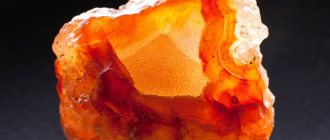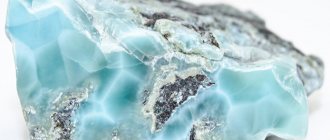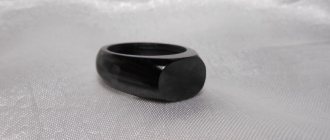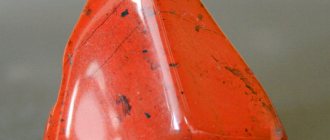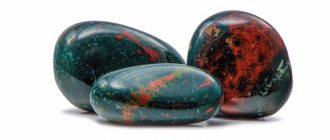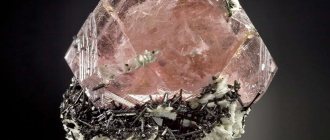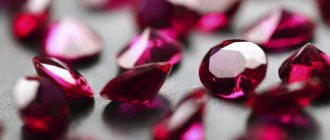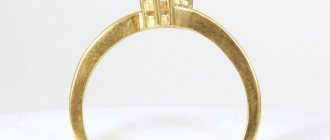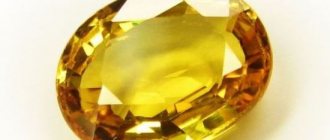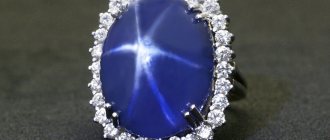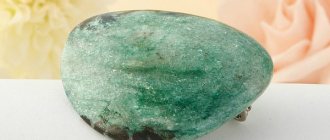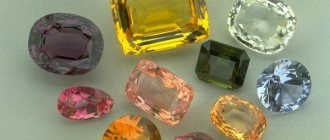| Category | Phosphates (minerals) |
| Title in English | Apatite |
| Formula | Ca5[PO4]3 |
| Group | Mineral group |
| Color | White, Green, Blue-green, Light Blue, Purple, Red |
| Stroke color | White to yellowish gray |
| Shine | Glassy to greasy |
| Transparency | Transparent, Translucent to Opaque |
| singonia | Hexagonal |
| Hardness | 5 |
| Cleavage | Imperfect |
| Density, g/cm³ | 3,2 — 3,4 |
| Kink | Conchoidal |
| origin of name | Apatite is a derived name from the Greek word ἀπατάω, which translates as “deception.” Such an interesting name was given due to the fact that the semi-precious stone can easily be confused with amethyst, tourmaline, topaz, beryl or diopside. |
| Morphology | The most common form of apatite occurs as prismatic, pre-acicular crystals. However, tabular forms are also noted. |
The geological concept of “blende” is associated with rocks that imitate various nuggets. One of these “ardent deceivers” is apatite, as even the name of this mineral indicates. It contains calcium phosphate and pure calcium, which together form beautiful and regular geometric crystals of large sizes, similar to precious gems. Apatite aggregates can weigh hundreds of kilograms! But not all stones are suitable for jewelry. Small transparent crystals are considered the highest quality. And only a few of them are pure enough and suitable for cutting and making jewelry.
Apatite deposits
Large deposits of apatite are rare.
The largest known one is located on the Kola Peninsula (Russia), where there are deposits of apatite ore that contain fluorapatite and nepheline (apatite nepheline ores). Large apatite crystals (moroxites) are mined in Transbaikalia. — Advertising —
In addition, apatite is mined in countries such as Brazil, Mexico, USA, Chile, South Africa, Finland, Spain, and Norway.
History of apatite
The first scientific description of apatites was made at the end of the 18th century by the scientist A.G. Werner, who proposed a name for the stone. The word “apatite” is of ancient Greek origin and is translated as “I deceive.” It indicates that natural apatite is extremely diverse and can superficially resemble other stones, such as beryl, diopside and tourmaline. A diagnostic feature of apatite is the prismatic shape of its crystals and relatively low hardness.
A little about mineralogy
Science loves to systematize and put in order, to give descriptions of objects. For the abundance of stones, rocks, crystals, this has always been relevant. Therefore, hardworking scientists divided the minerals that they saw and studied into classes.
Minerals in general for scientists are products of chemical reactions. It doesn’t matter that they (the reactions) took place not in a flask, but in a volcano, for example. Mineral classes are divided according to their chemical composition and crystal structure. There are many classes of minerals.
Why diamond is so hard and shines so brightly is because it has a special crystal lattice. Why is mercury classified as a mineral? It doesn’t have crystals, it’s liquid.
Our hero apatite belongs to the class of phosphates. This is the most numerous class of minerals. He was called a “deceiver,” but it would be more correct to call him “many-faced.” The physical properties, forms of release, and color of these minerals are striking in their diversity.
Physico-chemical characteristics of apatite
In terms of their chemical composition, apatites belong to mixed calcium phosphates.
As additional elements, apatite often contains fluorine, chlorine, manganese, iron, strontium, aluminum, thorium, and rare earth elements. — Advertising —
The shape of the mineral crystals is varied: from prismatic to needle-shaped, less often short-columnar or tabular. Apatites are characterized by the presence of granular sugar-like aggregates, dense masses, radial and columnar aggregates. The fine-fiber structure is much less common.
Pure apatite crystals are colorless, completely transparent or translucent. Their color depends on the composition of impurities, for example, iron gives the mineral a smoky or yellowish tone, blue and green apatites contain manganese and lead.
The gem is characterized by the manifestation of luminescence, due to which it changes its color from different viewing angles. Blue and yellow examples are often decorated with a cat's eye effect.
The hardness of apatite on the Mohs scale is 5, which is quite low for jewelry processing and requires careful handling of the stone.
Varieties, colors
As mentioned above, depending on the composition, the stones differ from each other in color and composition.
Based on these characteristics, apatites are divided into 3 groups:
Fluorapatite
Chloropatite
Hydroxylapatite
The first group includes minerals that contain fluorine. This group is distinguished by a wide variety of colors. It includes purple, pink, yellow, brown and even transparent apatites.
Chloropatite also comes in several green, gray and pink-white shades. Their name speaks for itself and indicates that they contain a lot of chlorine.
And finally, the third group of hydroxylapatites includes white, blue, red, and violet minerals. They contain a lot of water.
Magical properties of apatite
All owners of jewelry and talismans with apatite are guaranteed to prevent serious upheavals in life.
This gem causes prophetic dreams to appear; it endows its owner with insight and a strong intuitive awareness of dangerous situations. Interestingly, if the stone is worn on the body, it begins to behave very actively. For example, when danger approaches, the skin that comes into contact with the stone begins to become irritated, itchy and red. And if at the same time there is a desire to get rid of the decoration, it means that the danger has reached its maximum. Still, it’s not worth parting with apatite. It is believed that when a stone is separated from its owner, it loses all its properties and becomes a dull and colorless piece of rock.
But apatite cannot damage, so it has never been used in black magic rituals.
Who is suitable according to their zodiac sign?
It is worth understanding what significance apatite has for the zodiac signs and who it is suitable for according to the horoscope:
- Pisces is the only sign that is not recommended to wear this stone. Under its influence they become uninitiative and lethargic.
- Aries - the best character traits are revealed in them, and the negative ones disappear.
- Taurus - get rid of characteristic stubbornness, become wise and prudent.
- Gemini - begin to see prophetic dreams, acquire the gift of providence.
- Cancers become strong, influential and independent, and deal more easily with problems that arise.
- Leos reveal their talents to the fullest, without fear of condemnation.
- Virgos - get rid of melancholy and sad thoughts, become easy to communicate and stop criticizing others.
- Libra - they stop doubting everything, get rid of slowness and apathy, and gain determination.
- Scorpios become kinder and more restrained, they begin to understand people well.
- Sagittarius - get rid of torment and doubt.
- Capricorns - the amulet protects them from making mistakes.
- Aquarians – become less excitable and nervous.
Healing properties of apatite
For the healing properties of apatite to manifest, it must be combined with other healing minerals.
For example, crystals of yellow and brown shades in combination with other similar minerals stimulate the heart, and if blue apatites are combined with aquamarines, they will help a lecturer or singer. The harmonization of the human condition is facilitated by the combination of intensely blue apatites with jewelry made of rock crystal and diamonds.
With the help of green apatites, depression and depressed states are treated. Blue-green crystals have a calming and peaceful effect.
Applications of apatite
Non-gem quality apatite is a raw material in the production of phosphate fertilizers, phosphorus compounds and phosphate acid.
The mineral is used in ferrous and non-ferrous metallurgy, for the production of ceramics and glass. Jewelers use apatite quite rarely, which is due to its low hardness and fragility. Typically, gem-quality apatites barely reach 5 carats, and extremely rarely – 20 carats. As a rule, such samples are an object of collector's interest, especially if they are well cut, translucent and transparent.
Talismans and amulets
The power of this stone will grow over time. Therefore, the longer you manage to wear apatite, the more it will protect you.
It will simply serve as an irreplaceable talisman for those whose professions involve risk and are life-threatening. For example, it will definitely bring good luck to high-rise builders, police officers, firefighters and stuntmen.
Also, this stone is recommended for doctors and teachers. He will bring good luck during the journey and ward off all bad luck.
How to distinguish real apatite from a fake
Apatite itself is not counterfeited, but the gem itself, even the name of which is translated as “deception,” is quite often confused with tourmalines, topazes, beryls, amethysts, diopsides and aquamarines. The main difference between apatite and precious and semi-precious stones is its low hardness.
How to care for apatite
Like all relatively soft and fragile stones, apatite needs to be treated very carefully, protected from mechanical influences, shocks and scratches.
Jewelry with apatite should not be left exposed to direct sunlight for a long time. Clean apatite using a damp soft cloth.
Meaning to people
For humans, the mineral is of great importance. It’s not for nothing that it’s called the “bread stone.” We have been eating bread grown using apatite fertilizers (superphosphates) for a long time.
Many industries cannot do without the mineral. The chemical extracts phosphorus from it and produces phosphoric and orthophosphoric acids. Without apatite, “bone china” cannot be produced. And where to find so many bones to create royal porcelain - that’s where apatite comes to the rescue.
Ring with apatite
Minerals containing phosphates are used in foundry.
Phosphorus glass, which freely transmits ultraviolet light, is also a merit of apatite. If you want glass that will block infrared rays, no problem. Apatite will help you. Why are they needed? Didn’t you steam in your apartment when it was 50 degrees Celsius? If not, you're in luck. Surgeons burn their hands during long operations without such glass. Let’s not even talk about working in “hot” shops. Without such glass it's just hell.
We recommend: HELIOLITE - stone of the Sun
Textile, match, ceramic, food industries, military affairs - they cannot do without a variety of stones.
So the use of our mineral helps a person in many ways.
Educational: if you wanted to look at an irreplaceable stone, it’s very simple. In the human body, apatite makes up a large proportion of bones, teeth (and even kidney stones).
Prices for apatite products
Considering the varied properties and quality of apatites, their prices also vary widely. For example, transparent, clean samples with a beautiful cut are valued at $2-3 per carat. Heterogeneous stones with defects are valued much lower. Beads are often made from them. The cheapest specimens of apatite are those that are ground into cabochons. Such stones are opaque and layered. Pendants and other small jewelry are made from fractured apatites, the cost of which is very low.
